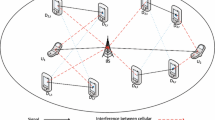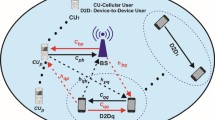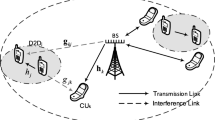Abstract
Future radio communication systems become user-centric and lay more emphasize on individual quality-of-service (QoS) experience than system-wide performance. Being a potential component, Device-to-Device (D2D) communication underlaying cellular network attracts great attention and explores the proximate gain residing in local communicating pairs, but co-channel interference is inevitable between D2D links (D-Ls) and the existing cellular links (C-Ls), and the design of resource allocation should be addressed. So, we are dedicated to balancing the performance tradeoff between the system capacity (SC) of D-Ls, i.e., the number of admitted D-Ls with satisfied QoS requirement, and their system-wide metric, e.g., energy conservation, system throughput, energy efficiency, and the minimum individual data rate, and we specify our optimization model to enhance the system-wide metric on condition that the SC is maximized and the QoS requirement of prioritized C-Ls is also strictly guaranteed. Finally, a two-step mechanism is proposed: In step one, we devise a joint admission control and channel assignment scheme for SC maximization from graph perspective. In step two, we further incorporate power control of the D-Ls admitted in previous step for supreme system-wide metric. With the help of numerical results, we demonstrate the necessity to weight the above performance tradeoff and elucidate the efficacy of our mechanism.
Access this article
Rent this article via DeepDyve




Similar content being viewed by others
References
Cisco. (2015). Cisco Visual Networking Index: Global Mobile Data Traffic Forecast Update, 2014–2019, White Paper. http://www.cisco.com/c/en/us/solutions/collateral/service-provider/visual-networking-index-vni/white_paper_c11-520862.pdf
Cheng, R.-G., Chen, N.-S., Chou, Y.-F., & Becvar, Z. (2015). Offloading multiple mobile data contents through opportunistic device-to-device communications. Springer Wireless Personal Communications. doi:10.1007/s11277-015-2492-1.
Chang, B.-J., Liang, Y.-H., & Su, S.-S. (2015). Analyses of relay nodes deployment in 4G wireless mobile multihop relay networks. Springer Wireless Personal Communications. doi:10.1007/s11277-015-2443-x.
Tanbourgi, R., Jäkel, H., & Jondral, F. K. (2014). Cooperative interference cancellation using device-to-device communications. IEEE Communications Magazine, 52(6), 118–124.
Chávez-Santiago, R., Szydelko, M., Kliks, A., Foukalas, F., Haddad, Y., Nolan, K. E., et al. (2015). 5G: the convergence of wireless communications. Springer Wireless Personal Communications. doi:10.1007/s11277-015-2467-2.
Osseiran, A., Boccardi, F., Braun, V., Kusume, K., Marsch, P., Maternia, M., et al. (2014). Scenarios for 5G mobile and wireless communications: The vision of the METIS project. IEEE Communications Magazine, 52(5), 26–35.
Chiang, M., Hande, P., Lan, T., & Tan, C. W. (2008). Power control in wireless cellular networks. Hanover, MA: Now Publishers Inc.
Katzela, I., & Naghshineh, M. (2000). Channel assignment schemes for cellular mobile telecommunication systems: a comprehensive survey. IEEE Communications Surveys & Tutorials, 3(2), 10–31.
Knopp, R., & Humblet, P. A. (1995). Information capacity and power control in single-cell multiuser communications. In IEEE International Conference on Communications (ICC) (pp. 331–335).
Leong, K. K., & Sung, C. W. (2006). An opportunistic power control algorithm for cellular network. IEEE/ACM Transactions on Networking, 14(3), 470–478.
Chen, Y., Zhang, S., Xu, S., & Li, G. Y. (2011). Fundamental trade-offs on green wireless networks. IEEE Communications Magazine, 49(6), 30–37.
Faybusovich, L. (2001). Power control under finite power constraints. Communications in Information and Systems, 1(4), 395–406.
Yu, C.-H., Doppler, K., Ribeiro, C. B., & Tirkkonen, O. (2011). Resource sharing optimization for device-to-device communication underlaying cellular networks. IEEE Transactions on Wireless Communications, 10(8), 2752–2763.
Zulhasnine, M., Huang, C., & Srinivasan, A. (2010). Efficient resource allocation for device-to-device communication underlaying LTE network. In IEEE 6th international conference on wireless and mobile computing, networking and communications (WiMob) (pp. 368–375).
Jänis, P., Koivunen, V., Ribeiro, C., Korhonen, J., Doppler, K., & Hugl, K. (2009). Interference-aware resource allocation for device-to-device radio underlaying cellular networks. In IEEE vehicular technology conference-spring (VTC-S) (pp. 1–5).
Ji, L., Klein, A., Kuruvatti, N. & Schotten, H. D. (2014). System capacity optimization algorithm for D2D underlay operation. In IEEE international conference on communications workshops (ICC) (pp. 85–90).
Feng, D., Lu, L., Yi, Y.-W., Li, G. Y., Feng, G., & Li, S. (2013). Device-to-device communications underlaying cellular networks. IEEE Transactions on Communications, 61(8), 3541–3551.
Yin, C., Wang, Y., Lin, W., & Wang, X. (2014). Energy-efficient channel reusing for device-to-device communications underlaying cellular networks. In IEEE vehicular technology conference-spring (VTC Spring) (pp. 1–5).
Zhu, D., Wang, J., Swindlehurst, A. L., & Zhao, C. (2014). Downlink resource reuse for device-to-device communications underlaying cellular networks. IEEE Signal Processing Letter, 21(5), 531–534.
Zhang, J., Wu, G., Xiong, W., Chen, Z., & Li, S. (2013). Utility-maximization resource allocation for device-to-device communication underlaying cellular networks. In IEEE Globecom workshops (GC Wkshps) (pp. 623–628).
Cai, X., Zheng, J., Zhang, Y., & Murata, H. (2014). A capacity oriented resource allocation algorithm for device-to-device communication in mobile cellular networks. In IEEE international conference on communications (ICC) (pp. 2233–2238).
Wen, S., Zhu, X., Lin, Z., Zhang, X., & Yang, D. (2013). Energy efficient power allocation schemes for device-to-device (D2D) communication. In IEEE vehicular technology conference-fall (VTC Fall) (pp. 1–5).
Wu, D., Wang, J., Hu, R. Q., Cai, Y., & Zhou, L. (2014). Energy-efficient resource sharing for mobile device-to-device multimedia communications. IEEE Transactions on Vehicular Technology, 63(5), 2093–2103.
Oduola, W. O., Li, X., Qian, L., & Han, Z. (2014). Power control for device-to-device communications as an underlay to cellular system. In IEEE international conference on communications (ICC) (pp. 5257–5262).
Shalmashi, S., Miao, G., Han, Z., & Slimane, S. B. (2014). Interference constrained device-to-device Communications. In IEEE international conference on communications (ICC) (pp. 5245–5250).
Xu, C., Song, L., Han, Z., Zhao, Q., Wang, X., Cheng, X., et al. (2013). Efficiency resource allocation for device-to-device underlay communication systems: A reverse iterative combinatorial auction based approach. IEEE Journal on Selected Areas in Communications, 31(9), 348–358.
Zhang, R., Cheng, X., Yang, L., & Jiao, B. (2013). Interference-aware graph based resource sharing for device-to-device communications underlaying cellular networks. In IEEE wireless communications and networking conference (WCNC) (pp. 140–145).
Zhang, Q., Zhu, X., Wu, L., & Sandrasegaran, K. (2013). A coloring-based resource allocation for OFDMA femtocell networks. In IEEE wireless communications and networking conference (WCNC) (pp. 673–678).
Qiu, T., Xu, W., He, Z., Niu, K., & Tian, B. (2011). Graph-based spectrum sharing for multiuser OFDM cognitive radio networks. In International conference on wireless communications & signal processing (WCSP) (pp. 1–5).
Wang, F., Xu, C., Song, L., Zhao, Q., Wang, X., & Han, Z. (2013). Energy-aware resource allocation for device-to-device underlay communication. In IEEE international conference on communications (ICC) (pp. 6076–6080).
Tang, R., Zhao, J., & Qu, H. (2014). Distributed power control for energy conservation in hybrid cellular network with device-to-device communication. China Communications, 11(3), 27–39.
Wang, F., Xu, C., Song, L., Han, Z., & Zhang, B. (2012). Energy-efficient radio resource and power allocation for device-to-device communication underlaying cellular networks. in international conference on wireless communications & signal processing (WCSP) (pp. 1–6).
Jung, M., Hwang, K., & Choi, S. (2012). Joint mode selection and power allocation scheme for power-efficient device-to-device (D2D) communication. In IEEE vehicular technology conference spring (VTC-S) (pp. 1–5).
Ausiello, G., Crescenzi, P., Gambosi, G., Kann, V., Marchetti-Spaccamela, A., & Protasi, M. (2003). Complexity and approximation—Combinatorial optimization problems and their approximability properties. Berlin: Springer.
Andersin, M., Rosberg, Z., & Zander, J. (1996). Gradual removals in cellular PCS with constrained power control and noise. Kluwer Wireless Networks, 2(1), 27–43.
Chiang, M. (2005). Geometric programming for communication systems. Hanover, MA: Now Publishers Inc.
Boyd, S., & Vandenberghe, L. (2004). Convex optimization. Cambridge, MA: MIT Press.
Acknowledgements
This work is supported in part by the National High Technology Research and Development Program of China (863 Program) (No. 2014AA01A706), the National Natural Science Foundation of China (No. 61531013), and the Research Fund of Ministry of Education-China Mobile (No. MCM20150102).
Author information
Authors and Affiliations
Corresponding author
Rights and permissions
About this article
Cite this article
Tang, R., Zhao, J. & Qu, H. Capacity-Oriented Resource Allocation for Device-to-Device Communication Underlaying Cellular Networks. Wireless Pers Commun 96, 5643–5666 (2017). https://doi.org/10.1007/s11277-017-4439-1
Published:
Issue Date:
DOI: https://doi.org/10.1007/s11277-017-4439-1




